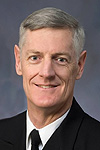Chris Mossey to lead Long-Baseline Neutrino Facility
 |
|
Chris Mossey
|
Building the world's most powerful long-baseline neutrino experiment will be a project unlike any Fermilab has led to date. It will bring together numerous significant research contributions from partners around the globe to construct the largest international DOE research facility ever hosted on U.S. soil.
The importance of the project led to the recent creation of a second deputy director position at Fermilab. And now, as of July 20, the role is filled: Chris Mossey is the new deputy director for the Long-Baseline Neutrino Facility. He joins Nigel Lockyer, Joe Lykken and Tim Meyer as a member of the directorate team.
A retired and decorated rear admiral in the United States Navy, Mossey has decades of experience overseeing the effective, sustainable construction of large and complex facilities. Although the goals of LBNF are very different from the facilities projects of his Navy career, Mossey sees similarities between the two organizations.
"I am very excited to be joining Fermilab," Mossey said. "What I enjoyed about the Navy was that I got to work with a dedicated group of people doing meaningful work. Those are the same reasons that I am looking forward to joining Fermilab: talented and dedicated people doing important work. I am really fortunate to be a part of this team."
Construction of LBNF will involve building several large underground detectors at two sites 800 miles apart for the future Deep Underground Neutrino Experiment. At the helm of this prodigious undertaking, Mossey will work to establish and maintain connections between the international partners, coordinate all aspects of construction, and deliver the project safely, on budget and on schedule.
"I am sure I have only an inkling of what to expect," he said. "It's a very ambitious project but one that many extraordinary people have been laying critical groundwork for over many years."
Along with Deputy Director Lykken, Mossey will also act as a champion for Fermilab's neutrino program.
"I look forward to being at a place where science is the area of focus, where the mission is no less than better understanding the universe, and working with the people who help advance that understanding," he said.
As commander of the U.S. Navy's Naval Facilities Engineering Council, Mossey led a global organization of 19,000 people executing Navy construction and facility programs that provided more than $12 billion in annual facilities engineering, construction and maintenance services. Mossey most recently worked as a consultant with the planning firm Marstel Day.
"Chris's work building complex facilities is highly respected, and he brings a wealth of experience to Fermilab," said Fermilab Director Nigel Lockyer. "We are happy that he is joining us in building the future of U.S. particle physics, and we are fortunate that he will be an ambassador for us to the world."
—Deb Sebastian and Leah Hesla
|